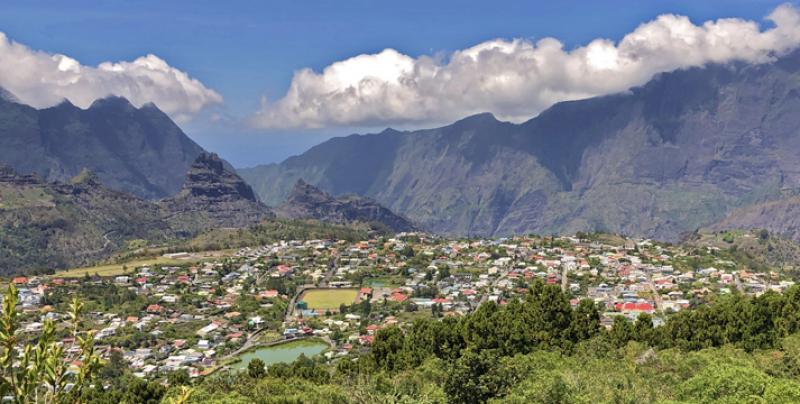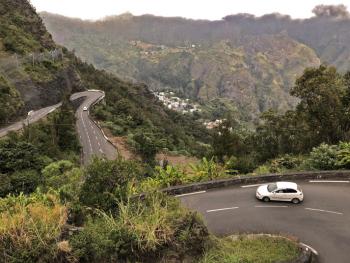Smitten with Réunion Island
This item appears on page 12 of the February 2021 issue.
On our way to visit remote Madagascar in May 2019, my adventurous adult son, Eirik, and I decided to visit an even more remote place, a dot on the map named Réunion.
Located in the Indian Ocean between Madagascar and Mauritius, this 28-mile-wide, 39-mile-long volcanic island is similar to Maui, Hawaii.
It was created at a hot spot in the Earth’s crust and, coincidentally, is at the same latitude in the Southern Hemisphere as Maui is in the Northern Hemisphere. Unlike Maui, however, this tropical island is officially part of France. Its roads are funded by the European Union, and its bakeries sell decadently rich chocolate croissants.
We found French to be the primary language in restaurants, markets, bakeries and hotels, and we managed with our basic skills. Someone at the car rental agency and a manager at one of our apartments did speak English.
With a rush of adrenaline, Eirik and I set out to explore Réunion’s one very active volcano, Piton de la Fournaise, as well as three steep and deep cirques; these vast, sheer-sided basalt bowls are the remains of the ancient volcano Piton des Neiges.
Our quest began in one of these vast calderas, the Cirque de Cilaos, where we maneuvered along a rising roadway with 400 or so sharp curves that wound around cloud-capped mountaintops. Every horizon was filled with jagged peaks that enclosed the caldera. Tiny villages perched precariously on areas of flat terrain, which were scarce.
The panoramic views were breathtaking, and we stopped the car often to enjoy the scenery. We became enthralled with this wild and winding geography, curvy road included.
We chose to stay in the small town of Cilaos (pop., 5,000) for six days. Its four fresh vegetable markets, two French pastry shops and a well-stocked grocery store were more than adequate for delicious meals we cooked at the apartment.
During our stay, we explored nearby hamlets at the ends of curvaceous roads by riding the pink buses, operated by Alternéo (www.alterneo.re [in French only]), that visit all the villages in this cirque. Schedules can be viewed and tickets purchased at the website. In our case, when we wanted to ride, we walked the five blocks from our apartment to a station in town and (in French) purchased tickets there. Tickets purchased on the bus cost a little more.
Once on board, when we wanted to get off at a bus stop, we followed the local custom of clapping our hands to signal our intent.
We are avid hikers and took full advantage of the 40 miles of trails, many through verdant virgin forests. My son hiked the strenuous routes, and I hiked the leisurely flat ones. Rocky waterfalls and spectacular vistas made these outings memorable.
After six days, we drove out of Cirque de Cilaos, navigating those 400 challenging curves again (with more confidence this time), and drove across the middle of the island. Along the way, we stopped to pick wild red guavas with locals and passed a cabbage field, a cornfield and a patch of tomatoes. Banana trees were growing everywhere.
We detoured to Piton de la Fournaise to see its fresh lava fields but didn’t take time to hike there.
After a 4-hour drive, we arrived in the other caldera that can be visited by car, Cirque de Salazie (pop. 8,000). This caldera has the lion’s share of waterfalls and enough pullouts for drivers to stop for photographs or just to drink in the panoramic views.
During our 3-day stay, Eirik hiked across a rocky ridge into Cirque de Mafate (pop. 700), where there are no roads, while I ambled for three hours in the opposite direction along a gravel road lined with blue-flowering jacaranda trees, narrow streams and groves of tree ferns. These were magnificent hikes for both of us!
The last stop of our May 16-23 visit began with an easy freeway drive from the town of Salazie to the capital, Saint-Denis (pop. 150,000). Saint-Denis boasts beautifully restored 19th-century Creole mansions and a wide variety of restaurants. We spent two days visiting museums and sampling French and Indian cuisines.
I was smitten with Réunion, but we continued on and caught our flight to Madagascar.
Remarkably, Air Austral offers nonstop flights from Saint-Denis to Bangkok, Paris, Marseilles, Madagascar and Johannesburg. Even more remarkable, we were able to return to Réunion six months later on our way to South Africa.
During our second visit, Nov. 3-12, 2019, we discovered an alpine lake with its own waterfall, a convenient apartment by the airport and more fabulous forest trails to hike. We rejoiced that there were fewer tourists and that a new pastry shop had opened in Cilaos.
The weather in November was similar to what it had been in May — cool mornings and warm afternoons, with intermittent rain and low clouds.
During our first visit, we lodged at La Belle Créole (36A rue Saint-Louis, CILAOS 97413; phone +262 693 03 13 84), where our apartment cost $84 per night, and at Le Guétali (29 Chemin Camp Pierrot, SALAZIE 97433; phone +262 692 82 84 83), where our apartment cost $77 per night.
On our second visit, we stayed at Jolie T2 duparc ste-Marie (5 rue Marcel Goulette, Sainte-Marie 97438, SAINT-DENIS; phone +262 693 20 41 39); our apartment cost $77 per night.
The euro was the local currency, but credit cards were accepted everywhere.
Our car reservations were made through Expedia.com with the Germany-based SIXT (in the US, 888/749-8227, www.sixt.com); drivers from the US need to have an international driver’s license. In May, for one driver and with unlimited mileage, our price for nine days was $556, which included the more expensive insurance my son always buys.
Although we knew what to expect on our second visit, we still stopped the car often to enjoy the steep, sharp ridges and the wide, walled vistas of the calderas. Again, we savored French pastries.
Réunion may be a remote destination, but it is well worth visiting, even twice!
ANN CABOT
Austin, TX



